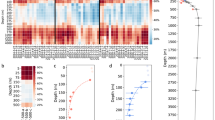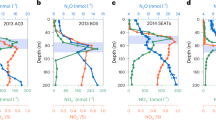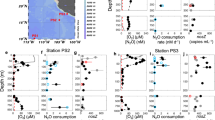Abstract
METHANE is an important component of the global carbon cycle1 and a potent greenhouse gas2,3. Surface ocean waters are typically supersaturated with dissolved methane relative to atmospheric equilibrium, presumably as a result of in situ microbial methane production4–8. Because methanogenic bacteria are strict anaerobes9and surface ocean waters are highly oxygenated, the observation of methane supersaturation has been termed the 'oceanic methane paradox'10. Although methanogenic bacteria have been isolated from oceanic particulate matter, faecal pellets and zooplankton11–14, no data are available on in situ rates of methane formation in these microenvironments. During a series of experiments in the North Pacific ocean, we have identified a previously unrecognized component of the oceanic methane cycle. We find that methane is associated with sinking particles, presumably as a dissolved constituent of the interstitial fluids of particulate biogenic materials, which exchanges with the water column as particles sink. This phenomenon provides a mechanism for the active transport in the water column of an otherwise passive, dissolved species. The particle-to-seawater methane flux that we measure is sufficient to replace all of the methane present in the upper water column in about 50 days and to produce the characteristic methane supersaturations in less than a month. We suggest that particulate production and transport may also be relevant to the redistribution and cycling of other bioreactive compounds in the marine environment.
This is a preview of subscription content, access via your institution
Access options
Subscribe to this journal
Receive 51 print issues and online access
$199.00 per year
only $3.90 per issue
Buy this article
- Purchase on Springer Link
- Instant access to full article PDF
Prices may be subject to local taxes which are calculated during checkout
Similar content being viewed by others
References
Martens, C. S. in Microbial Growth on C1 Compounds (eds Crawford, R. L. & Hanson, R. S.) 276–281 (Am. Soc. for Microbiology, Washington DC, 1984).
Tyler, S. C. in Microbial Production and Consumption of Greenhouse Gases: Methane, Nitrogen Oxides, and Halomethanes (eds Rogers, J. E. & Whitman, W. B.) 7–38 (Am. Soc. for Microbiology, Washington DC, 1991).
Cicerone, R. J. & Oremland, R. S. Global Biogeochem. Cycles 2, 299–327 (1988).
Brooks, J. M., Reid, D. F. & Bernard, B. B. J. geophys. Res. 86, 11029–11040 (1981).
Burke, R. A. Jr, Reid, D. F., Brooks, J. M. & Lavoie, D. M. Limnol. Oceanogr. 28, 19–32 (1983).
Lamontagne, R. A., Swinnerton, J. W., Linnenbom, V. J. & Smith, W. D. J. geophys. Res. 78, 5317–5324 (1973).
Scranton, M. I. & Brewer, P. G. Deep-Sea Res. 24, 127–138 (1977).
Traganza, E. D., Swinnerton, J. W. & Cheek, C. H. Deep-Sea Res. 26, 1237–1245 (1979).
Boone, D. R. in Microbial Production and Consumption of Greenhouse Gases: Methane, Nitrogen Oxides, and Halomethanes (eds Rogers, J. E. & Whitman, W. B.) 57–70 (Am. Soc. for Microbiology, Washington DC, 1991).
Kiene, R. P. in Microbial Production and Consumption of Greenhouse Gases: Methane, Nitrogen Oxides, and Halomethanes (eds Rogers, J. E. & Whitman, W. B.) 111–146 (Am. Soc. for Microbiology, Washington DC, 1991).
Bianchi, M., Marty, D., Teyssie, J.-L. & Fowler, S. W. Mar. Ecol. Prog. Ser. 88, 55–60 (1992).
Sieburth, J. McN. in Microbes in the Sea (ed. Sleigh, M. A.) 11–38 (Ser. in Mar. Sci., Ellis Horwood, Chichester, 1987).
Oremland, R. S. Limnol. Oceanogr. 24, 1136–1141 (1979).
Marty, D. G. Limnol. Oceanogr. 38, 452–456 (1993).
Swinnerton, J. W. & Linnenbom, V. J. J. Gas Chromatogr. 5, 570–573 (1967).
Martin, J. H., Knauer, G. A., Karl, D. M. & Broenkow, W. W. Deep-Sea Res. 34, 267–285 (1986).
Laws, E. A., DiTullio, G. R., Betzer, P. R., Karl, D. M. & Carder, K. L. Deep-Sea Res. 36, 103–120 (1989).
Knauer, G. A., Martin, J. H. & Bruland, K. W. Deep-Sea Res. 26, 97–108 (1979).
Karl, D. M. & Knauer, G. A. Oceanogr. Mag. 2, 32–35 (1989).
Pace, M. L., Knauer, G. A., Karl, D. M. & Martin, J. H. Nature 325, 803–804 (1987).
Sieburth, J. McN. et al. Curr. Microbiol. 14, 285–293 (1987).
Karl, D. M., Tilbrook, B. D. & Tien, G. Deep-Sea Res. 38, 1097–1126 (1991).
Dagg, M. J. & Walser, W. E. Jr, Limnol. Oceanogr. 31, 1066–1071 (1986).
Karl, D. M. & Knauer, G. A. Deep-Sea Res. 31, 221–243 (1984).
Smith, K. L. Jr, Williams, P. M. & Druffel, E. R. M. Nature 337, 724–726 (1989).
Grimalt, J. O., Simoneit, B. R. T., Gomez-Belinchon, J. I., Fischer, K. & Dymond, J. Nature 345, 147–150 (1990).
Author information
Authors and Affiliations
Rights and permissions
About this article
Cite this article
Karl, D., Tilbrook, B. Production and transport of methane in oceanic particulate organic matter. Nature 368, 732–734 (1994). https://doi.org/10.1038/368732a0
Received:
Accepted:
Issue Date:
DOI: https://doi.org/10.1038/368732a0
This article is cited by
-
Characteristics of vertical distributions of methane and dimethylsulphoniopropionate in the southern Yap Trench
Journal of Oceanology and Limnology (2023)
-
Multiple sources of aerobic methane production in aquatic ecosystems include bacterial photosynthesis
Nature Communications (2022)
-
Aerobic oxidation of methane significantly reduces global diffusive methane emissions from shallow marine waters
Nature Communications (2022)
-
Methane in the Yellow Sea and East China Sea: dynamics, distribution, and production
Journal of Oceanology and Limnology (2022)
-
Quantification of methanogenic Archaea within Baltic Sea copepod faecal pellets
Marine Biology (2020)
Comments
By submitting a comment you agree to abide by our Terms and Community Guidelines. If you find something abusive or that does not comply with our terms or guidelines please flag it as inappropriate.



